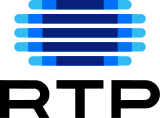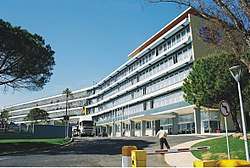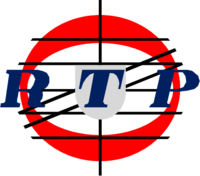Rádio e Televisão de Portugal
RTP, formally Rádio e Televisão de Portugal (Radio and Television of Portugal), is the public service broadcasting organisation of Portugal. It operates four national television channels and three national radio channels, as well as several satellite and cable offerings.
 | |
| Sociedade Anónima, public service broadcaster | |
| Industry | Mass media |
| Genre | Public broadcasting service |
| Founded | 1935 as Emissora Nacional 1955 as Radiotelevisão Portuguesa 2004 as Rádio e Televisão de Portugal |
| Founder | Government of Portugal |
| Headquarters | Cabo Ruivo, Lisbon , Portugal |
Area served | Portugal |
Key people | Gonçalo Reis, Chairman of the Board |
| Services | Television, radio, online |
| Revenue | €240.225 million[1] (2018) |
| Owner | Government of Portugal |
Number of employees | 1597[2] (2018) |
| Subsidiaries | Radio channels TV channels |
| Website | www.rtp.pt |

.jpg)
The current company dates from 2007, with the merger of two previously separate companies Radiodifusão Portuguesa (RDP; the radio broadcaster) and Radiotelevisão Portuguesa (television broadcaster), although they had been grouped under a single holding company and common branding since 2004.
RTP is funded by the taxa de contribuição audiovisual (broadcasting contribution tax), which is incorporated in electricity bills, and television advertising revenues.
History
Radio
The Emissora Nacional de Radiodifusão (ENR) was established on 4 August 1935 as the public national radio broadcaster, inheriting the previous broadcasting operations of the national postal service, Correios, Telégrafos e Telefones (CTT). Five years later, ENR became independent of the CTT.
ENR was one of the 23 founding broadcasting organisations of the European Broadcasting Union in 1950. Following the Carnation Revolution, ENR was reorganised and in 1976 changed its name to Radiodifusão Portuguesa (RDP). During this process, several previously private radio stations – such as Rádio Clube Português (RCP) – were nationalised and integrated into RDP.
In 1979, the RCP network was rebranded as Rádio Comercial, and was later privatised in 1993. At the same time, RDP launched the youth-oriented radio station Antena 3 and abolished advertising from all of its stations, so that the aforementioned broadcasting contribution tax became its sole source of funding.
Television
Radiotelevisão Portuguesa's television service was established on 15 December 1955. Experimental broadcasts began in September 1956 from the Feira Popular (an entertainment park) studios in Lisbon. Twenty monitors were installed in the park, but crowds gathered in shops around the city. The broadcast was received within a range of about 20 km. Around 1,000 TV sets are sold within a month.
Regular broadcasting, however, did not start until 7 March 1957, by which time coverage had reached approximately 65% of the Portuguese population. By the end of 1958 the total number of sets in Portugal was around 32,000. RTP was accepted as a full active member of the EBU in 1959. By the mid-1960s, RTP had become available throughout the country. Robert Farnon's "Derby Day" was extensively used as RTP's fanfare to open the programming since the very first day, and over the decades it has become RTP's official anthem.
25 December 1968 saw the opening of a second television channel, RTP2. Two new regional channels were created in 1972 and 1975, for the Portuguese archipelagos of Madeira (opening on 6 August 1972) and the Azores (10 August 1975).
Before the Carnation Revolution, RTP was essentially a mouthpiece of the regime, and famously opened the newscast of 20 July 1969 – the day of the first moon landing – with a segment showing president Américo Thomaz opening a concrete factory. However, like many other broadcasters, it did broadcast live the landing of the man on the moon during the night.
The first colour broadcast was made in 1975, with the live coverage of the first parliamentary elections after Carnation Revolution. But, due to the political turmoil and the economic situation of the country, the colour regular broadcast was delayed several times for nearly 5 years. During that time RTP started to purchase some colour equipment and make the occasional colour recording. But the pressure kept going as the black and white equipment was getting old and very hard to repair, so in 1978 and 1979 a massive investment supported by a foreign loan, gave RTP the opportunity to replace all the B/W to increase the current amount of equipment and to be updated with the most advanced broadcast technologies available at the time. Despite this, only in February 1980, the government finally authorised the regular colour broadcast and two weeks after, on the 7th of March RTP started the regular colour broadcast, with more than 70% of the programmes being already in colour. Also, RTP moved its headquarters to a brand new building. The building was originally built to be converted to a hotel, but the owner decided to leave it untouched and reached an agreement with RTP for the purchase and converted the interior for office use. RTP moved to more adequate headquarters and sold the building in 2003 and the new owner converted into what is today the VIP Grand Lisboa.
Until 1991, RTP owned its transmitter network, which was transferred to a state-owned enterprise which, through a series of mergers, became part of Portugal Telecom. RTP held the television monopoly until 1992, the year when the private SIC (backed by Impresa, TSF, Rádio Comercial, Lusomundo, Expresso, Impala Editores, and the largest commercial TV network in Latin America Rede Globo) started broadcasting. Over the years, RTP's audience share has constantly reduced in favour of the private channels. 2007 was an exception to this tendency, and RTP1 became the second channel most watched in Portugal, only behind TVI, a rarity which occurred again in 2009 and 2010.
In 2004, RTP and RDP were organized under a new company and became part of a larger state-owned holding, named Rádio e Televisão de Portugal, SGPS, and inaugurated the new headquarters near Parque das Nações, in Lisbon. In the same year, the second channel was rebranded as '2:', promoting itself as the civil society service. Later in March 2007, 2: became 'RTP2' again. In February 2007 Radiotelevisão Portuguesa SA (the former RTP) and Radiodifusão Portuguesa SA (RDP) were merged into the new Radio e Televisão de Portugal SA,[3] ceasing to be independent entities. Due to the financial crisis Portugal faced, RTP was to be heavily restructured as part of the (2011-2015) Portuguese government's austerity plan and would have included the sale of one of the free to air channel licenses. Pressure from the public and other organisations stopped the planned channel privatization, although some restructuring took place, namely the phasing out of the international shortwave radio channels.
RTP has 16 regional offices spread all over the country, as well as international bureaus in Washington D.C., Brussels, Moscow, Brazil and several other locations.
RTP aired the 1996 Olympic Games in HD through the ZON TV Cabo satellite and cable platform. On 30 September 1997, RTP 1 HD returned in an experimental broadcast.
Following Salvador Sobral's win in the Eurovision Song Contest 2017, RTP took on hosting duties for the 2018 contest.
Post-merger
The use of original full names of radio and television departments (Radiodifusão Portuguesa and Radiotelevisão Portuguesa, respectively) was phased out, but the abbreviation RDP is still used by international services RDP Internacional and RDP África, as well as radio services in the Autonomous Regions of Azores and Madeira, while another abbreviation RTP now represents the merged company.
Logo history
 RTP's first, original and old logo used from 7 March 1957 to 1959.
RTP's first, original and old logo used from 7 March 1957 to 1959. First phase of RTP's second and former logo used until 25 December 1968.
First phase of RTP's second and former logo used until 25 December 1968. Second phase of RTP's second and former logo used until 1982.
Second phase of RTP's second and former logo used until 1982. Logo, 1982 - 1995
Logo, 1982 - 1995 Logo, 1996 - 2003
Logo, 1996 - 2003 Logo, 2004 - 2014
Logo, 2004 - 2014 Logo, 2015–present
Logo, 2015–present Current logo with the full name.
Current logo with the full name.
Television channels
| Channel | Description | Slogan | Aspect ratio/Resolution | Launched | Teletext |
|---|---|---|---|---|---|
| RTP1 | The oldest of RTP's channels and also the flagship of RTP. It features general programming, such as news, talk shows, current affairs, drama, national and international movies and TV series.a, b; | Continua | 16:9 SDTV/HDTV | 7 March 1957 | Yes |
| RTP2 | The main channel for cultural and factual programming, as well as children's programming. It was the first free-to-air TV channel in Portugal to broadcast in 16:9 format.a, b; | Culta e adulta | 25 December 1968 | ||
| RTP3 | 24-hour news channel a, b, c; | Informação, informação, informação | 16:9 SDTV | 15 October 2001 | |
| RTP Memória | Broadcasts classic RTP and International shows a, b; | Traz pr'á frente | 4 October 2004 | ||
| RTP Madeira | Regional opt-out channel broadcast in the Madeira Islands; | Liga a Madeira | 6 August 1972 | ||
| RTP Açores | Regional opt-out channel broadcast in the Azores Islands; | Unimos as ilhas | 10 August 1975 | ||
| RTP Internacional | Also known as RTPi, it is the international television service. In Macau, East Timor and Goa, Daman and Diu it is retransmitted locally, together with local programming c; | Sente Portugal (Portuguese) Feel Portugal (English) |
10 June 1992 | ||
| RTP África | International television service directed towards the African communities. In Angola, Mozambique, Cape Verde, Guinea-Bissau and São Tomé e Príncipe it is retransmitted locally, together with local programming b d; | vários mundos, uma só língua | 7 January 1998 |
Former channels
- RTP Mobile, is a channel adapted to mobile devices. It ended in 2011/2012, with the ascension of mobile apps.
- RTP 4K, which was used to broadcast UEFA Euro 2016 matches in 4K Ultra HD.
a Terrestrial channel available nationwide.
b Available on the Portuguese cable, satellite and IPTV platforms.
c Available worldwide on satellite and cable platforms.
d Available in several African countries on satellite and cable platforms as well as traditional terrestrial television.
Radio stations

- Antena 1, news, talk and sports station with a strong focus on Portuguese music;a b c e
- Antena 2, cultural programming, classical and world music, featuring live performances;a c
- Antena 3, an up-tempo, youth-oriented station with focus on contemporary and alternative music; a
International
- RDP Internacional, the international radio service;c
- RDP África, programming directed towards the Portuguese-speaking African communities;a e
Digital
- Rádio Lusitania, a digital-only station with a focus on Portuguese music;d e
- Rádio Vivace, a digital-only station with a focus on Classical music;d e
- Rádio ZigZag, a digital-only station with a focus on Children's programmes;d e
- Antena 1 Fado, a digital-only station with a focus on fado;d e
- Antena 1 Memória, a digital-only station with a focus on rebroadcasts of programmes from the extensive archives of RDP and golden oldies music (in both cases from the 1930s to the 1980s). It is the only station to rely entirely on pre-existing recorded programmes and material;d e
- Antena 1 Vida, a digital-only station;d
- Antena 2 Ópera, a digital-only station with a focus on opera music;d
- Antena 2 Jazzin, a digital-only station with a focus on jazz music;d
- Notes
a Available nationwide on FM and online.
b Also available on AM.
c Available on satellite all over the world.
d Available only on the internet.
e Also available throughout Portugal via cable and satellite.
News services
Most RTP1 news programmes are simulcasted with RTP Internacional, RTP África, and, sometimes, RTP 3 television channel. These news programs include:
- Bom Dia Portugal (6:30−10 am), live from the Lisbon studios;
- Jornal da Tarde (1 pm), live from the Porto studios;
- Portugal em Direto (6 pm), live from the Lisbon studios;
- Telejornal (8 pm), live from the Lisbon studios.
RTP2’s only news service is Jornal 2 (‘Journal 2’ or ‘News 2’ in English) (9 pm), a shorter and a more objective newscast than the RTP1 ones.
RTP3 features hourly news updates and headlines.
Organisation
Chairmen of the board
- Almerindo Marques, 2002−2008
- Guilherme Costa, 2008−2012
- Alberto da Ponte, 2012−2015
- Gonçalo Reis, 2015−present
Managing Editors
- José Rodrigues dos Santos, 2001−2004
- José Alberto Carvalho, 2004−2011
- Nuno Santos, 2011−2012
- Paulo Ferreira, 2012–2014
- José Manuel Portugal, 2014–2015
- Paulo Dentinho, 2015–2018
- Maria Flor Pedroso, 2018–present
Programming directors of RTP1
- Nuno Santos, 2002−2007
- José Fragoso, 2008−2011, 2018−
- Hugo Andrade, 2011-2015
- Daniel Deusdado, 2015–2018
Programming directors of RTP2
- Manuel Falcão, 2003−2006
- Jorge Wemans, 2006−2012
- Hugo Andrade, 2012-2014
- Elíseo Oliveira, 2014-2015
- Teresa Paixão, 2015–present
See also
- List of Portuguese language television channels
- Festival da Canção
- Television in Portugal
- Digital television in Portugal
- Sociedade Independente de Comunicação
- Televisão Independente
- Luis Miguel Loureiro, RTP journalist
References
- "Relatório e Contas 2018" (PDF). RTP.
- "Relatório e Contas 2018" (PDF). RTP.
- "Diário da República Eletrónico 14 de fevereiro de 2007". DRE.pt. Retrieved 24 May 2019.
External links
- Official Site (in Portuguese)
- Live Radio
- Radiotelevisão Portuguesa (RTP) on IMDb (in English)